This article has been reviewed according to Science X's editorial process and policies. Editors have highlighted the following attributes while ensuring the content's credibility:
fact-checked
peer-reviewed publication
trusted source
proofread
Oral agent found to produce high response rate in patients with multiple myeloma when combined with steroid

A new agent that subverts myeloma cells from within while also subjecting them to an immune system attack produced impressive responses in combination with dexamethasone in patients with multiple myeloma that had relapsed and stopped responding to all currently available therapies, a clinical trial conducted by researchers at Dana-Farber Cancer Institute and around the world has found. Results of the trial are being published by the New England Journal of Medicine, together with an accompanying editorial.
The responses are especially promising because the new agent, mezigdomide, is a pill that can be taken at home once daily, unlike many other immunotherapies that must be custom-made for each patient, are administered intravenously, and require sometimes lengthy hospital stays, the study authors noted.
The researchers were also encouraged that mezigdomide generated responses in half of patients who had received prior anti-B-cell maturation antigen (BCMA) targeted -therapy—including the two CAR T cell therapies achieving U.S. Food and Drug Administration approval over the last three years, as well as bispecific monoclonal antibodies and the antibody drug conjugate Belantamab Mafodontin.
The phase 1/phase 2 trial enrolled 178 patients with multiple myeloma who had previously received the standard therapy for the disease—a combination of three classes of drugs—and in some cases had been treated with BCMA targeting treatment, including CAR-T therapy. Participants took a 1 mg. pill of mezigdomide daily for three weeks and a 40 mg. pill of dexamethasone (20 mg. for older patients) every seven days during that period.
At a median follow-up of six months, more than 40% of participants had an objective response to the treatment—with at least a 50% reduction in disease burden or better, and in three cases, a sustained complete response, meaning the disease could not be detected even with the most sensitive tests.
"Our findings show that mezigdomide in combination with dexamethasone has important clinical activity in this group of patients with very hard to treat myeloma," said Dana-Farber's Paul Richardson, MD, who led the study with co-investigators across North America and Europe.
"This was particularly noteworthy because we were able to see responses in patients who had received prior BCMA-targeted therapy and in myeloma that had spread beyond the bone marrow and developed aggressive extramedullary disease, which is associated with an especially poor prognosis."
Mezigdomide was designed to fully degrade the activity of cell proteins known as Ikaros and Aiolos, which are transcription factors that help switch genes on and off. In myeloma cells, which depend heavily on Ikaros and Aiolos, their loss is a death blow. In blood cells known as mononuclear cells, by contrast, the loss of these proteins activates certain groups of T cells, among the immune system's most adept cancer fighters.
This powerful dual action makes mezigdomide more potent against myeloma than similar drugs known as immunomodulators or IMiD agents, which work by a similar but otherwise distinct mechanism, pre-clinical research has shown.
Participants in the study represented a broad cross-section of the myeloma patient population. They ranged in age from 42 to 85, the oldest of whom were ineligible for intensive immunotherapies like CAR T-cell therapy.
All had received at least three prior lines of treatment or more and were considered triple class refractory, such that they had relapsed and become resistant to currently approved drugs. Reflecting this, most of the participants had high-risk disease with adverse cytogenetics and other poor prognosis features, all of which typically do not respond well to standard therapies.
At the 6.25-month median follow-up mark, the response rate—the percentage of patients benefiting from the treatment—was 40.6%. The response rate in patients with extramedullary disease, which occurs when myeloma cells form tumors outside the bone marrow in other tissues and organs, the response rate was 30%. And in patients who had been treated with anti-BCMA therapy and subsequently progressed, it was a "remarkable" 50%, Richardson said.
The median progression-free survival for all the treated patients—reflecting how long patients lived before their disease showed signs of worsening—was just over four months, although that reflects early data and will probably increase over time, Richardson noted. Importantly, the median duration of response was longer at almost 8 months. Among patients who had a very good partial response to the therapy, the response lasted an average time of over nine months, although that figure is also likely to improve with time.
Correlative laboratory studies done using bone marrow and peripheral blood samples collected from patients participating in the trial showed that mezigdomide was highly active in patients whose myeloma had become resistant to the drug pomalidomide, as well as becoming previously refractory to lenalidomide, another key agent in myeloma treatment with similar, although less marked effects on the immune system.
This provided clinical proof that mezigdomide, which powerfully boosts T cell activity and natural killer cells, was critically able to overdrive resistance to these prior agents, as the pre-clinical studies suggested it would.
Importantly, the side effects of the mezigdomide/dexamethasone tandem proved generally manageable, investigators found. The most common complication was neutropenia, a decrease in white blood cell counts, which was readily reversible with the use of growth factor support and dose reduction of mezigdomide when needed. Very few patients dropped out of the trial because of adverse effects of the treatment.
"We're hopeful that this body of data provides substantial evidence of the value of this approach to patients with an urgent unmet medical need, and further supports this oral agent being tested in combination with other back bone therapies, where our preliminary results are already promising, and now are being evaluated as part of larger, ongoing phase 3 clinical trials," Richardson remarked.
More information: New England Journal of Medicine (2023).



















